40 Bad Back Wall Design Ideas for Supportive, Comfortable Living Spaces
When designing your back wall, steer clear of overly dark colors that can sap energy from the space. Cluttered wall shelving overwhelms, while inconsistent textures disrupt harmony. Overly minimalistic or excessive patterns can make your wall feel chaotic. Be mindful of poorly placed artwork and inappropriate wall art that don’t add value. Ignoring natural light can also diminish comfort. Discover further design missteps that can undermine your cozy living space.
Overly Dark Colors

When you choose overly dark colors for your back wall, it can make the space feel cramped and uninviting.
Dark color psychology often evokes feelings of heaviness and sadness. To counteract this, consider using lighter shades or creating color contrast effects with brighter accents.
This not only brightens your room but also fosters a more uplifting atmosphere, enhancing your overall living experience.
Cluttered Wall Shelving

Overly dark colors can already make a space feel cramped, but cluttered wall shelving takes that discomfort to another level.
You might think cluttered shelf organization is a practical solution, but it often overwhelms your wall space optimization efforts. Instead of showcasing your items, it creates chaos, making your living area feel smaller and less inviting.
Clear the clutter for a more open, harmonious environment.
Inconsistent Textures

While mixing textures can add depth and interest to your space, inconsistent textures on your back wall can create visual disarray.
Layered materials and contrasting elements might seem appealing, but when they clash, they disrupt harmony.
Stick to a cohesive theme with balanced textures to guarantee your back wall enhances your living space rather than detracts from it.
Consistency is key!
Poorly Placed Artwork
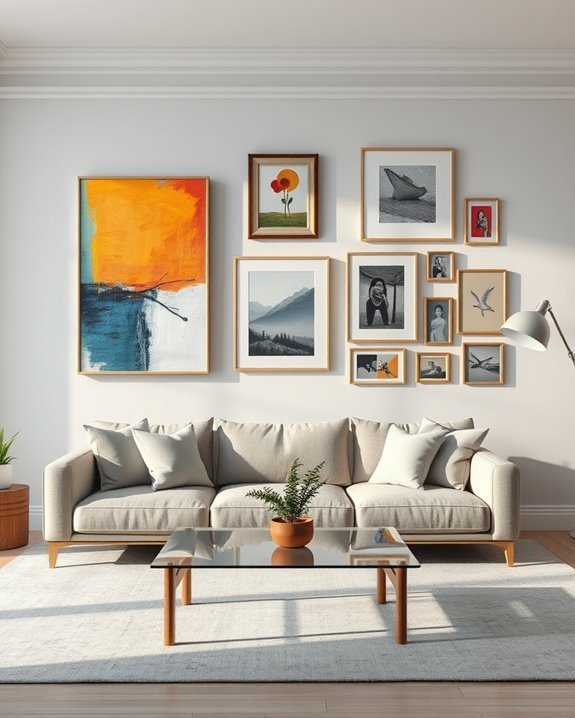
Inconsistent textures can lead to a chaotic appearance, and poorly placed artwork only compounds the problem.
When you hang art without considering the overall layout, you disrupt artistic balance and lose visual harmony.
Make certain your artwork complements other design elements, creating a cohesive look.
Thoughtful placement can elevate your space, enhancing both comfort and style while maintaining a serene atmosphere.
Excessive Patterns

When you fill your back wall with excessive patterns, it can overwhelm the space and create visual clutter.
Busy wallpaper and clashing prints can fight for attention, making it hard to relax in your living area. Instead of creating a cozy atmosphere, these patterns can distract and confuse, leaving you feeling unsettled.
Choose simpler designs to maintain harmony and comfort in your space.
Unbalanced Symmetry

Although symmetry can bring a sense of balance to your space, unbalanced symmetry can create chaos and discomfort.
When you mix eclectic arrangements without a thoughtful approach, the overall aesthetic can feel jarring.
Instead, aim for balanced colors and deliberate placements to maintain harmony.
This way, your living area will feel more inviting and cohesive, promoting a sense of comfort and stability.
Misaligned Furniture

Misaligned furniture can disrupt the flow of your space and create an awkward atmosphere.
When furniture placement is haphazard, it hinders space optimization, making your area feel cramped or uninviting.
To enhance your living environment, guarantee that your pieces align with each other and the room’s layout.
Thoughtful arrangements can foster a sense of harmony and improve overall comfort in your home.
Lack of Focal Point
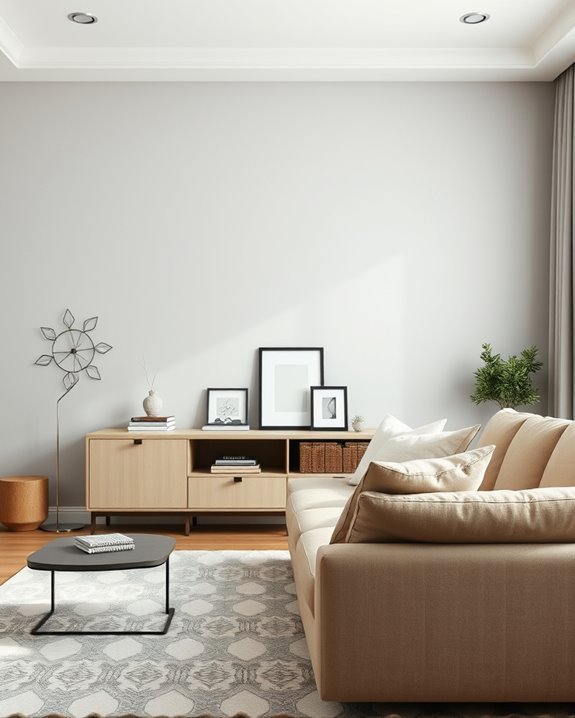
Without a clear focal point, a room can feel disjointed and uninviting.
You might notice a lack of visual interest, leaving the space feeling flat.
When vital design elements are missing, such as artwork or a statement piece, your walls can appear bare and unappealing.
It’s important to create a focal point that draws the eye and enhances the overall atmosphere.
Overwhelming Wall Decals
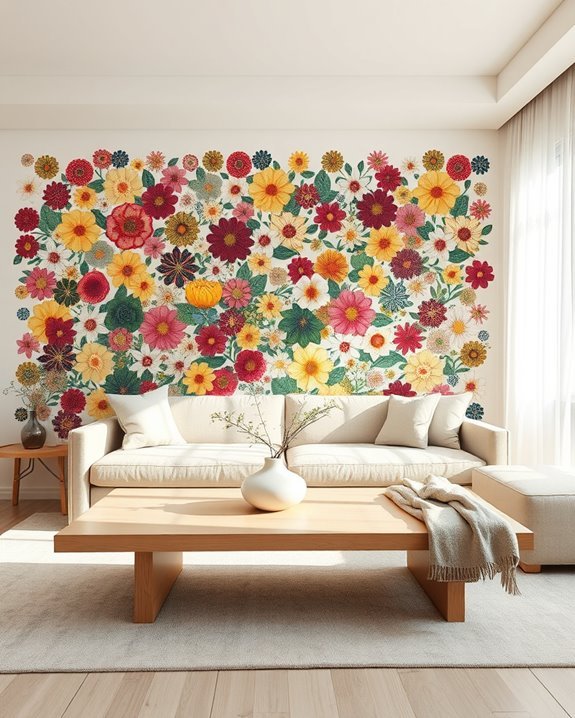
Bold wall decals can transform a space, but when overdone, they can overwhelm rather than enhance.
You might love the idea of vibrant, overwhelming colors, but excessive designs can create chaos instead of harmony.
It’s essential to balance your wall decor with the rest of the room.
Choose a few impactful decals to complement, not clutter, your living space.
Inadequate Lighting
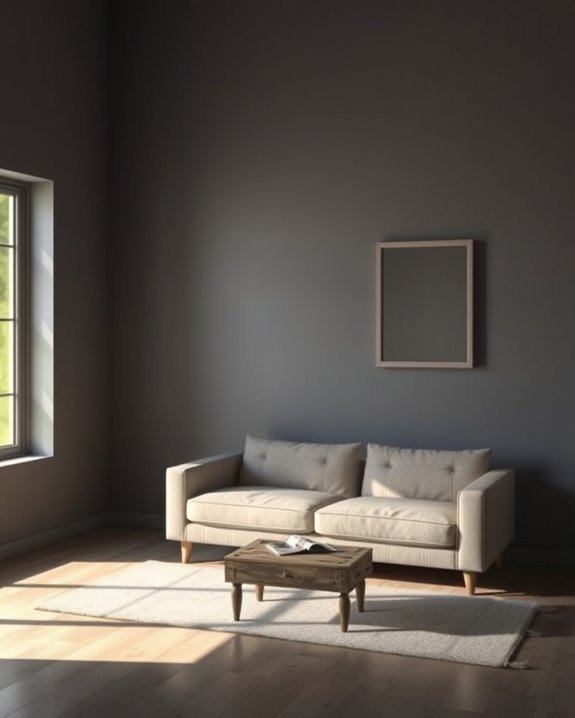
Excessive wall decals might steal the show, but inadequate lighting can easily sabotage your design efforts.
Without proper ambient lighting, your space can feel cramped and uninviting. Task lighting is essential for functionality, ensuring you can read or work comfortably.
Balance both types of lighting to create a warm, inviting atmosphere that complements your design rather than detracting from it.
Poorly Executed Accent Walls

While accent walls can enhance a room’s aesthetic, poorly executed designs can quickly overpower the space.
You might choose poor color choices that clash with existing decor, creating visual chaos. Ineffective textures can also detract from the proposed impact, making the wall seem disjointed.
To achieve a balanced look, select colors and textures that complement and harmonize with your overall design.
Ignoring Wall Proportions
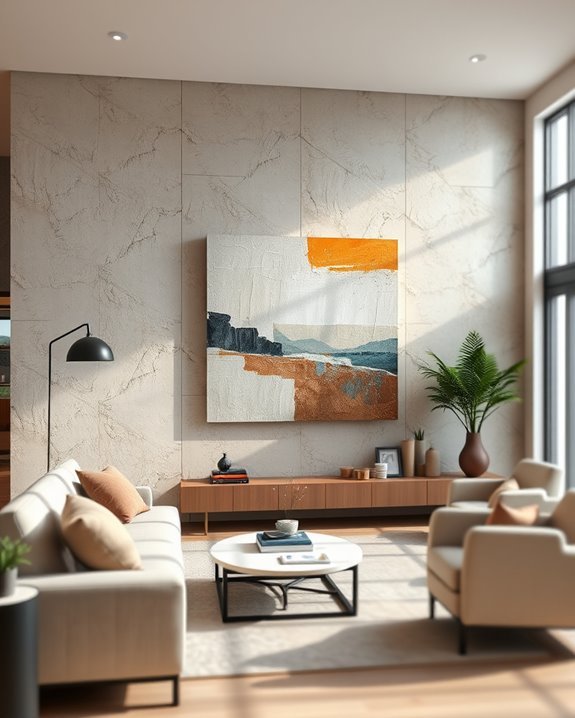
An accent wall can elevate a room, but ignoring wall proportions can lead to disappointing results.
You need to take into account the size and height of your walls for a balanced look. Without proper spatial awareness, your accent wall might overwhelm or underwhelm the space.
Keep wall proportions in mind to create a harmonious environment that enhances your living area’s overall appeal.
Overstuffed Wall Units
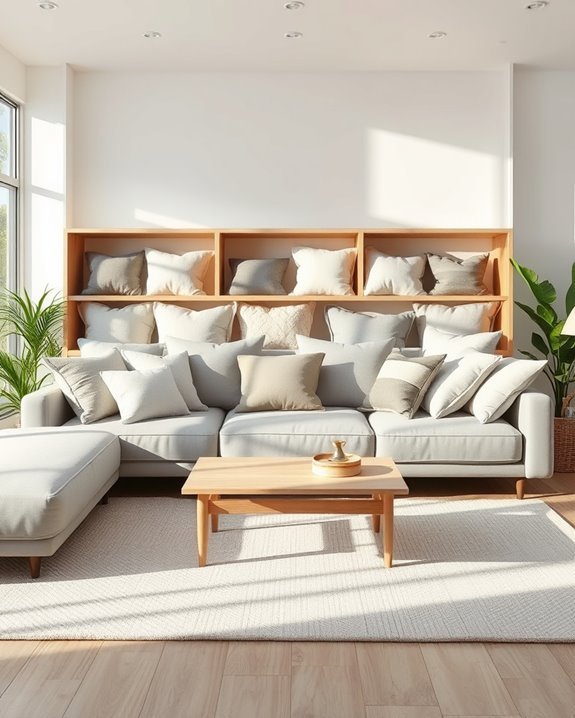
When you cram too many items into a wall unit, it can easily become a cluttered eyesore rather than a stylish focal point.
Overstuffed shelves make it difficult to find what you need, and bulky furniture can overwhelm the space. Instead of showcasing your decor, you’re left with a chaotic arrangement.
Simplifying your wall unit can enhance both aesthetics and functionality in your living area.
Unnecessary Wall Dividers
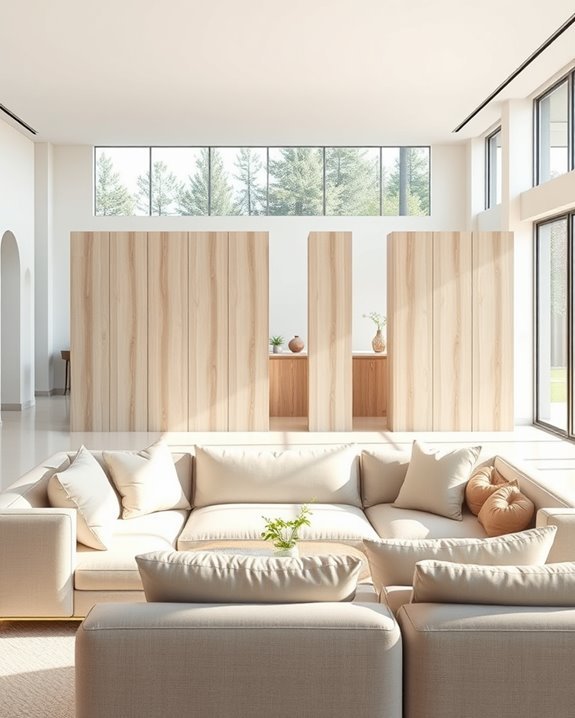
Overstuffed wall units can create clutter, but unnecessary wall dividers can compound the problem by breaking up your space in unflattering ways.
They disrupt space efficiency, making rooms feel cramped instead of open. Instead of enhancing aesthetic balance, these dividers often lead to a disjointed look.
Consider embracing open layouts that promote flow and harmony, enhancing both comfort and functionality.
Conflicting Color Schemes

How can conflicting color schemes undermine the overall design of your space? When colors clash, they disrupt color harmony, leaving your room feeling chaotic instead of inviting.
Design psychology shows that harmonious colors can positively affect mood and comfort. To create a supportive living environment, choose a cohesive palette that enhances your space, rather than one that detracts from its overall appeal.
Distracting Wall Hangings
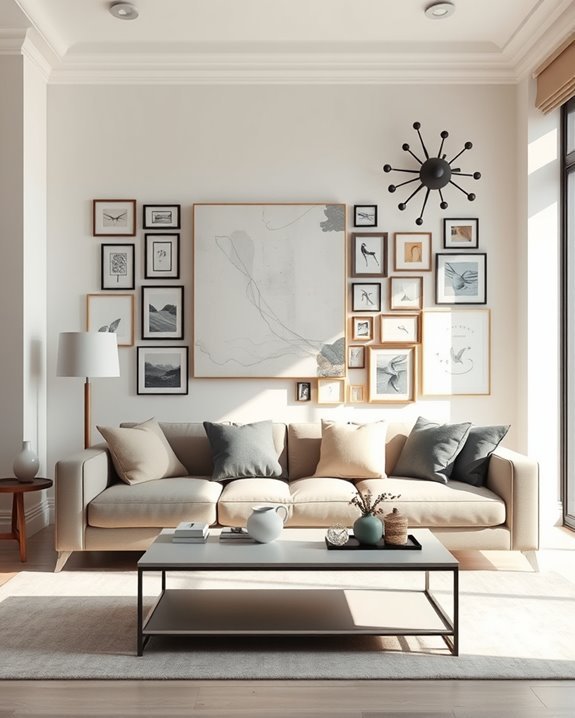
Conflicting color schemes can create a chaotic atmosphere, and the same goes for wall hangings that don’t complement your overall design.
Distracting colors and chaotic arrangements pull attention away from your desired focal points. Instead of enhancing your space, these wall hangings can overwhelm the room, making it feel disorganized.
Choose pieces that harmonize with your decor for a cohesive, inviting environment.
Neglecting Wall Maintenance
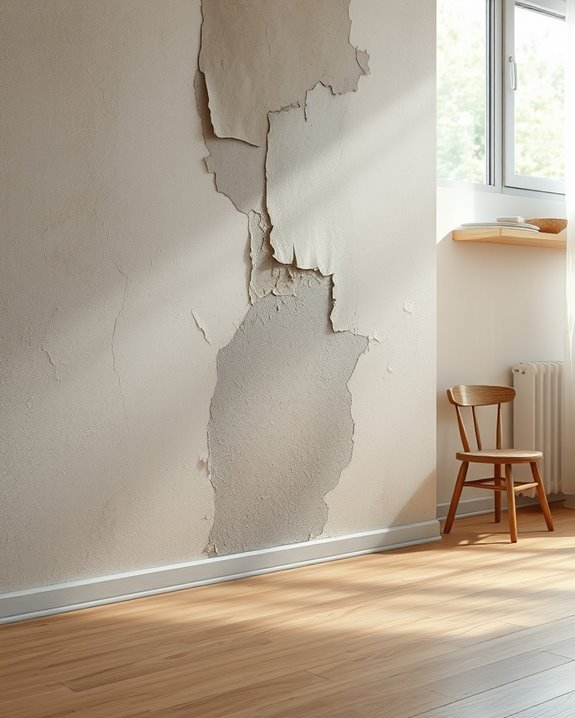
While you might be focused on decorating your walls, neglecting their maintenance can lead to significant issues down the line.
Regular wall upkeep is essential to prevent peeling paint, mold, or structural damage. Create a maintenance schedule to check for any signs of wear and tear.
Low-Quality Materials

When you choose low-quality materials for your back wall design, you risk compromising both aesthetics and durability.
Cheap alternatives may seem tempting, but they often come with subpar craftsmanship that can lead to bigger issues later. Instead of saving money, you might end up spending more on repairs.
Invest in quality materials to guarantee your living space remains supportive and comfortable.
Lack of Personal Touch

Many homeowners overlook the importance of adding a personal touch to their back wall design. A lack of personalized decor can make your space feel cold and uninviting.
Instead, consider incorporating unique artwork that reflects your personality and experiences. This not only enhances the visual appeal but also creates a warm atmosphere, turning your back wall into a true expression of who you are.
Overly Minimalist Designs
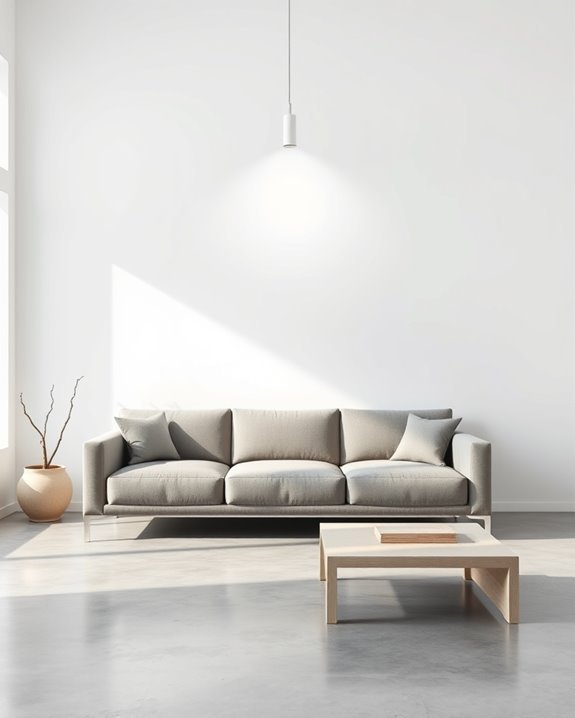
A back wall that leans too heavily into minimalism can feel stark and lifeless, stripping away any warmth or character from your space.
While minimalist functionality can create clean lines, it often sacrifices the cozy atmosphere you desire.
To achieve balance, blend minimalist warmth with textured elements or subtle colors, ensuring your wall not only looks good but also feels inviting and lived-in.
Incompatible Styles

While mixing styles can add depth to your design, incompatible elements often clash, creating a disjointed look that detracts from your space’s overall appeal.
You might find that combining clashing aesthetics leads to mismatched themes, making your room feel chaotic.
To achieve harmony, focus on blending complementary styles instead, ensuring each element enhances the overall design rather than competing for attention.
Disorganized Photo Galleries

Disorganized photo galleries can turn a beautiful back wall into a chaotic visual mess.
When you arrange your photos in a disorganized layout, it creates chaotic aesthetics that distract rather than inspire. Instead of showcasing your memories, a cluttered wall overwhelms the eye.
To enhance your space, opt for a cohesive arrangement that highlights your favorite moments without sacrificing visual harmony.
Underwhelming Wall Treatments

Underwhelming wall treatments can make even the most stylish spaces feel lackluster and uninspired.
When you choose underwhelming textures and uninspired colors, you risk creating an atmosphere that lacks personality and warmth.
Instead, opt for bold patterns, vibrant hues, or interesting materials that energize your walls.
Your living space deserves treatment that reflects your style and invites comfort.
Ignoring Room Functionality

When designing your back wall, overlooking the room’s functionality can lead to a space that feels impractical and uninviting.
Consider how you’ll use the area; incorporate functional furniture and create ergonomic layouts that enhance movement and comfort.
A well-thought-out design supports daily activities, making your living space more enjoyable and efficient.
Don’t sacrifice practicality for aesthetics—balance is key.
Outdated Design Trends

Ignoring the importance of current design trends can lead to a back wall that feels stale and uninspired.
Embracing outdated elements, like vintage wallpaper without modern touches, can dull your space.
Instead, consider blending bright accents with contemporary designs to breathe life into your walls.
Revitalizing your back wall can transform your living area from drab to dynamic with just a few thoughtful updates.
Uncomfortable Textiles

While you might love the look of certain textiles, choosing uncomfortable fabrics for your back wall can detract from the overall ambiance of your space.
Scratchy fabrics may irritate your skin, making relaxation difficult. Stiff upholstery can create an uninviting atmosphere, hindering comfort.
Opt for softer, more inviting materials to guarantee your living area feels cozy and welcoming.
Disregarding Scale
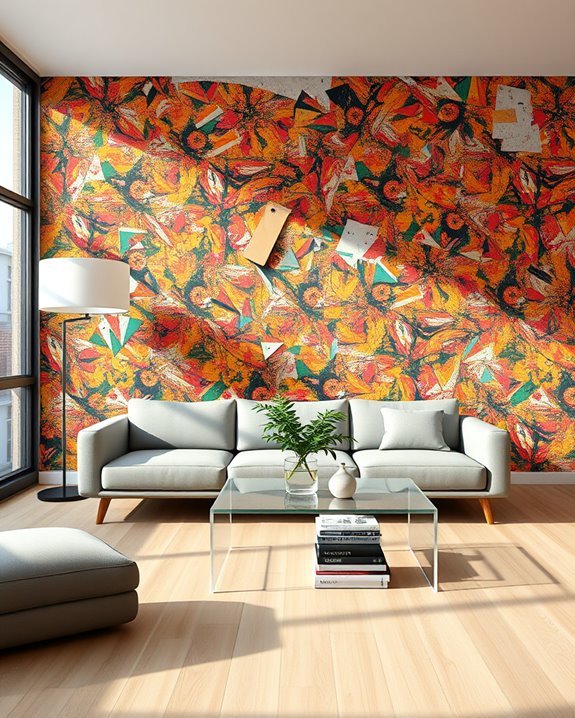
Although it might be tempting to choose oversized art or furniture for your back wall, disregarding scale can lead to a disjointed and cramped look.
Consider scale considerations carefully; large pieces in a small room can overwhelm the space.
Aim for proportionate design that complements your room’s dimensions.
Balancing size and style creates a harmonious environment, enhancing both comfort and aesthetics.
Uninviting Wall Colors

Choosing the right color for your back wall is just as significant as selecting the appropriate scale for your furnishings.
Dull paint and muted shades can make your space feel uninviting and lifeless. Instead of opting for these lackluster hues, consider bolder, more vibrant colors that energize your room and promote a welcoming atmosphere.
Your walls deserve a personality that reflects comfort and warmth.
Inflexible Layouts
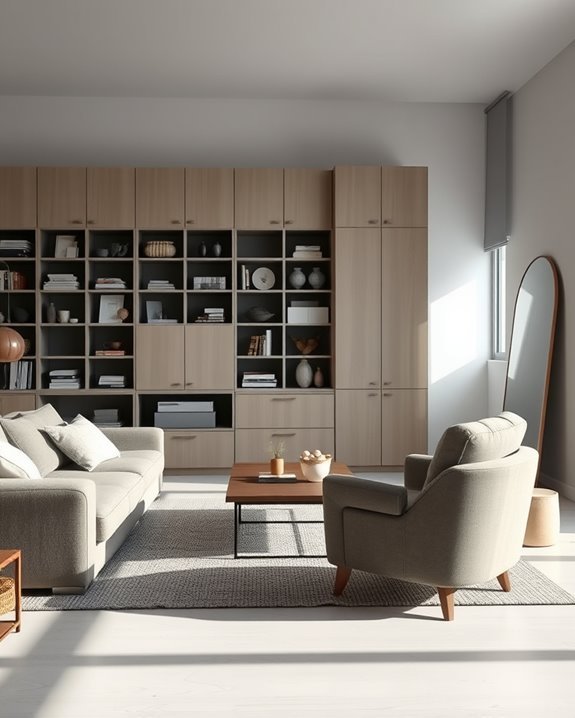
If you limit your layout options, your back wall can end up feeling cramped and uninviting.
Inflexible layouts restrict your design’s potential, creating spatial constraints that hinder movement and flow.
Instead of forcing furniture against the wall, consider versatile arrangements that promote openness.
Insufficient Storage Solutions

One of the biggest mistakes in back wall design is neglecting sufficient storage solutions.
Without creative storage options, your space can quickly feel cluttered.
Consider incorporating multifunctional furniture, like a sofa with built-in shelves or a coffee table that doubles as storage.
Maximizing your back wall with clever storage will enhance functionality and keep your living area organized and comfortable.
Unpleasant Wall Finishes
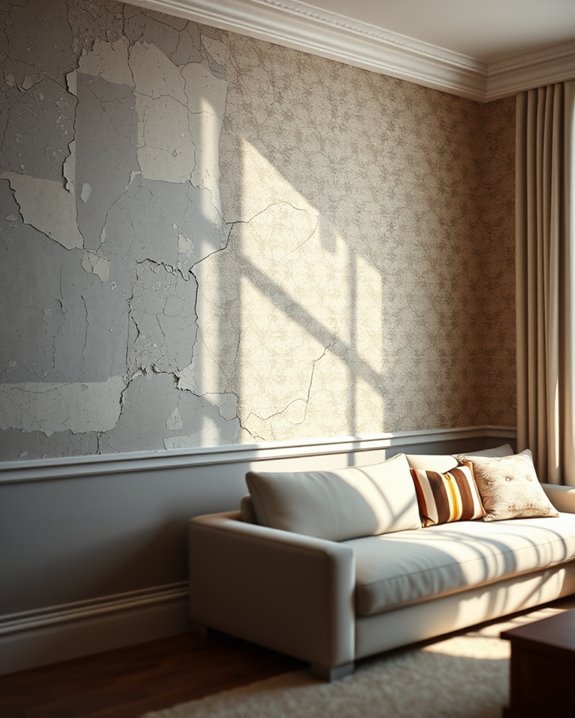
Clutter can be exacerbated by unpleasant wall finishes, which often detract from the overall appeal of your space.
Unpleasant textures, like rough or peeling surfaces, can create an uncomfortable atmosphere, while dull finishes might make your walls look lifeless.
Instead of drawing the eye, these finishes can overwhelm your room, making it feel chaotic and disorganized.
Consider revitalizing your walls for a more inviting environment.
Chaotic Wall Arrangements
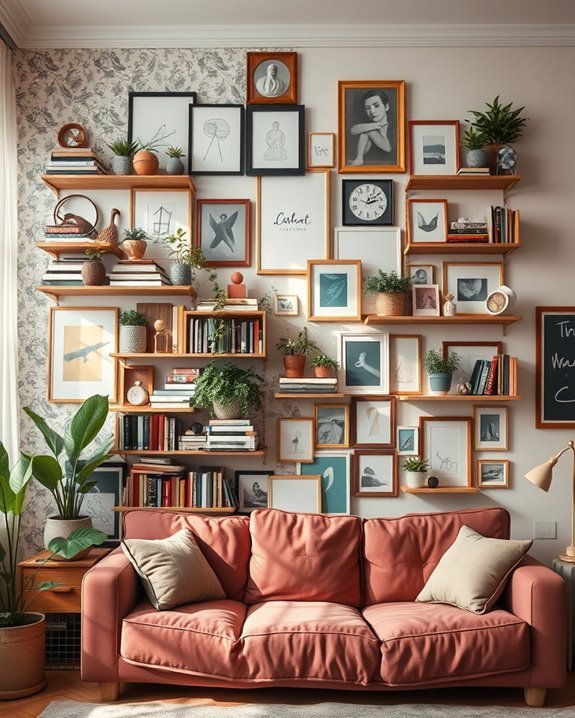
While a well-arranged wall can enhance a room’s character, chaotic wall arrangements can quickly detract from its overall appeal.
You might find that chaotic color combinations and disorganized layout patterns leave your space feeling cluttered and overwhelming.
Instead of fostering a warm atmosphere, these arrangements can create confusion, making it hard for guests to appreciate your style and comfort.
Neglecting Wall Soundproofing
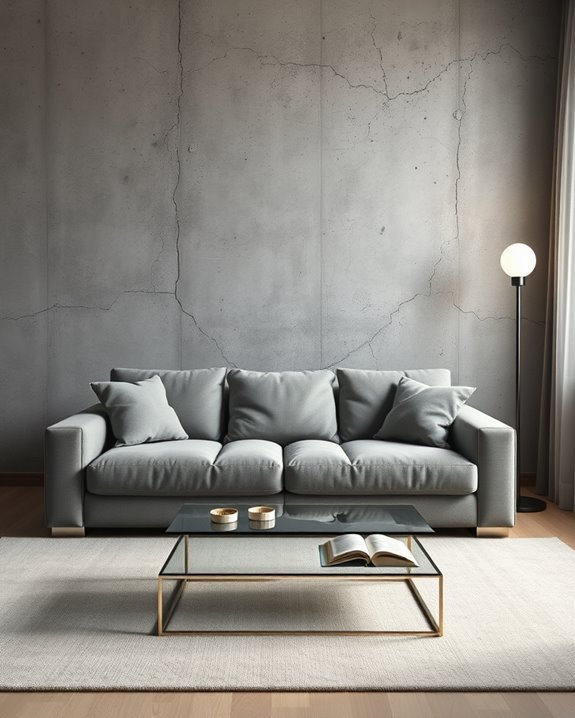
Ignoring wall soundproofing can lead to significant issues in your living space.
Without proper soundproofing materials, you’ll struggle with noise control and poor interior acoustics.
Incorporating wall insulation, sound barriers, and acoustic panels can enhance sound absorption, creating quiet spaces.
Consider effective wall treatments to achieve noise reduction, ensuring your home remains a comfortable retreat away from disruptive sounds.
Unappealing Wall Fixtures

Unappealing wall fixtures can instantly drag down the aesthetic of your space.
If you’ve got unattractive fixtures or awkward placements, they’ll catch your eye for all the wrong reasons. Instead of enhancing your decor, these elements can create an uninviting atmosphere.
Consider replacing them with stylish alternatives that complement your design, ensuring your walls contribute positively to your overall living experience.
Ineffective Use of Space

Ineffective use of space can make even the most stylish room feel cramped and chaotic. You should prioritize space optimization by choosing furniture that enhances functional design.
Avoid oversized pieces that dominate the area, and instead, select multi-functional items. Utilize vertical storage and consider layout adjustments to create a more open, inviting atmosphere.
Effective space usage transforms your living space into a comfortable haven.
Uncomfortable Wall Angles

When you have uncomfortable wall angles in a room, it can disrupt the flow and make the space feel uninviting.
Awkward angles create spatial disorientation, preventing you from fully enjoying the area. You might find it hard to arrange furniture or navigate the space comfortably.
To enhance your living environment, consider redesigning those angles for a more cohesive and welcoming atmosphere.
Poorly Designed Seating Areas

Although a well-designed seating area can enhance comfort and style, poorly arranged seating often leads to frustration and disconnect.
Uncomfortable seating can make gatherings less enjoyable, while impractical layouts may limit conversation flow.
When arranging your space, prioritize functionality and comfort to create an inviting atmosphere.
Avoid configurations that hinder movement or create awkward seating arrangements, ensuring everyone feels relaxed and included.
Overuse of Mirrors

While mirrors can create an illusion of space and light, overusing them can lead to a chaotic and disorienting environment.
Too many mirror reflections can clutter your walls and confuse the eye.
Be mindful of mirror placement; choose strategic locations that enhance your space without overwhelming it.
Striking a balance guarantees your home feels inviting rather than disorienting.
Inappropriate Wall Art

Choosing wall art can be a fun process, but it’s easy to miss the mark and end up with pieces that clash with your space.
Abstract shapes can feel out of place in a cozy room, while cultural references mightn’t resonate with everyone.
Be mindful of your selection to guarantee your art enhances rather than detracts from the overall comfort and style of your living area.
Ignoring Natural Light
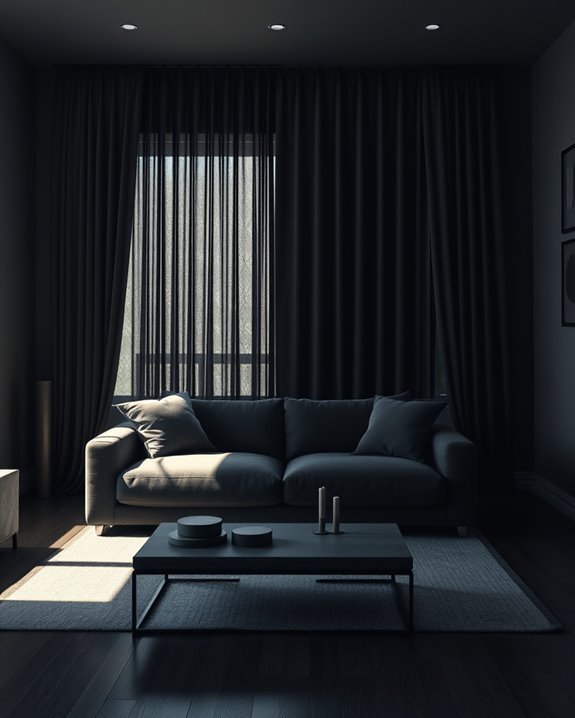
Neglecting the role of natural light in your wall design can lead to a dim and uninviting space.
Embracing natural light benefits can transform your environment, making it feel more open and welcoming.
Consider maximizing daylight by using lighter colors, strategic mirrors, or larger windows.
These choices create a vibrant atmosphere, enhancing your overall comfort and well-being in your living space.
Conclusion
To sum up, avoiding these 40 bad back wall design ideas can transform your living space into a supportive and comfortable haven. By steering clear of overly dark colors, cluttered shelves, and inconsistent textures, you’ll create an inviting atmosphere. Remember to choose wisely when it comes to artwork, patterns, and seating arrangements. Embrace natural light and thoughtful design to enhance your home’s aesthetic and functionality. A well-designed wall can truly elevate your everyday living experience.
